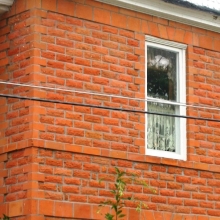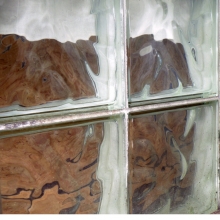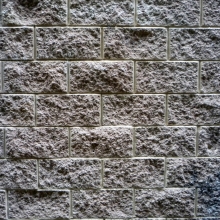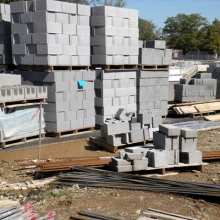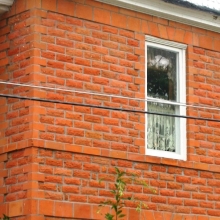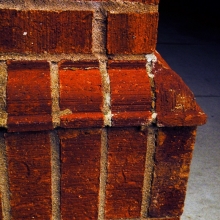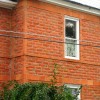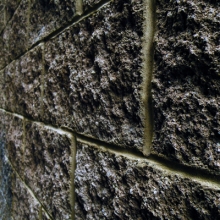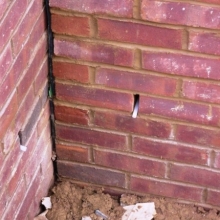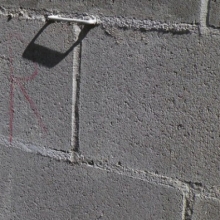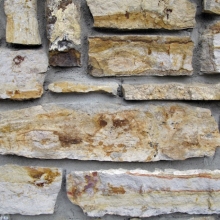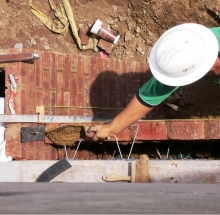Glass Unit Masonry
Glass block may be used as partitions, security barriers, or windows in interior or exterior applications where a partially-transparent effect is desired. Produced as solid or hollow units, glass block is available in clear or textured patterns, with applied tints and coatings, and with opacifiers and fiber fill.
Architectural Concrete Unit Masonry
Architectural concrete unit masonry is used as an architectural finish for interior and exterior walls, partitions, terrace walls, and other enclosures. Decorative CMU with textures, patterns, or other special finishes may be chosen for aesthetic attributes. Some units are available with the same treatment or pattern on both faces, to serve as both exterior and interior finish wall material.
Concrete Unit Masonry
Concrete unit masonry is a form of masonry which uses prefabricated concrete blocks, including hollow or solid architectural concrete masonry units (CMU). To be considered solid, units must be at least 75 percent solid. Hollow concrete units are preferred because of the reduced weight, easier handling, and lower cost.Concrete masonry units are made from hydraulic cement, water, and mineral aggregates with or without the inclusion of other materials. CMU are molded using a relatively dry mix of cement and aggregates; they are compacted and consolidated using low-frequency, high-amplitude vibration, and then cured under controlled temperature and humidity. These units are suitable for both loadbearing and non-loadbearing applications.
Ceramic Glazed Clay Masonry
This topic includes information related to design and construction with ceramic glazed clay masonry. Appropriate for both load-bearing and non-load-bearing applications, ceramic glazed clay masonry is a durable and resilient building material. Glazing ceramic over masonry allows for a multitude of color and finish options, that are resistant to fade, scratches and graffiti.
Brick Masonry
Brick Masonry is one of the oldest known man-made building materials, dating back to around 8000 B.C. Modern clay face brick comes in numerous standard sizes, most in nominal 4" widths, with nominal lengths of 8" or 12", and heights ranging from 2" to 5-1/3". Actual dimensions are normally 3/8" less than the nominal size, which allows for the typical mortar joint thickness. The most common size, "modular brick," measures 3-5/8" wide by 2-1/4" high by 7-5/8" long. This modular dimension works so that three bricks match the height and two bricks match the length of a standard nominal 8" by 16" concrete block or concrete masonry unit (CMU).
Clay Unit Masonry
Unit Masonry
Unit masonry, whether employing natural stone or manmade units, provides the designer with a broad variety of choices of materials, sizes, colors, and textures. Units may include solid or hollow clay brick, adobe, concrete block, glass block, structural clay facing tile, terra cotta, stone, or other special units. Masonry assemblies may be load-bearing or non-load-bearing, grouted or non-grouted, reinforced or non-reinforced, single- or multi-wythe. Whatever materials are used, the skill of the mason is key to a successful installation.
Masonry Accessories
Masonry accessories include materials incidental to masonry construction, including control and expansion joints, concealed flashing, drainage materials, weeps, and vents.
Masonry Anchorage and Reinforcing
Masonry anchorage and reinforcing perform the critical function of adding strength to masonry, either by transferring forces to the structure or by directly contributing resistance to applied loads. These systems are usually concealed within the masonry and therefore must be selected to resist corrosion, which could lead to catastrophic failure. Replacement of materials built into or embedded in masonry work is a very expensive and disruptive process.
Masonry Grouting
This topic includes information related to masonry grout used during construction. Masonry grout is a construction material that is applied as a thick liquid, which hardens over time. Masonry grout is composed of water, cement, sand, color tint and possible fine gravel. Commonly, masonry grout is used around rebar in masonry assemblies, between concrete assemblies, in joints and voids.
Masonry Mortaring
Although in ancient times masonry was often erected without mortar, the Romans discovered the benefit of using cement in making mortar to produce masonry structures which were stronger and more durable.
Contemporary Masonry Mortar is composed of cement, lime, sand, and water. The quality of the mortar depends upon the quality of its constituent parts, and the proportion of each affects the physical properties of the mortar. Each ingredient brings something different to the mix. Cement gives mortar its strength and durability; lime provides water retention, set control, and elasticity; sand acts as an inexpensive filler; and water contributes plasticity. Entrained air in the cement improves the mortar's resistance to freeze and thaw cycles.
